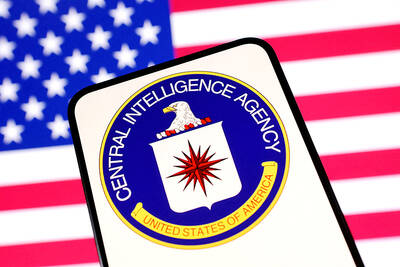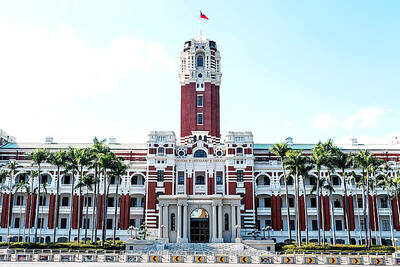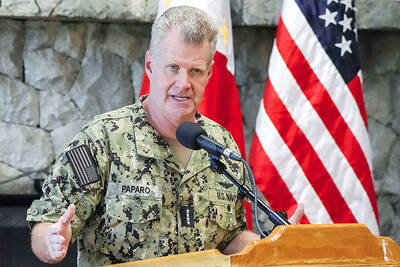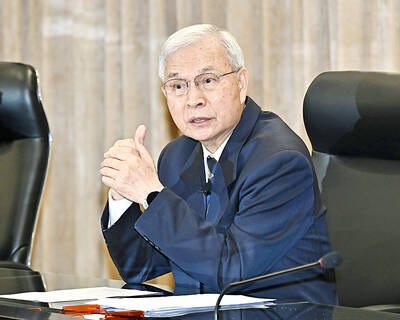A powerful new earthquake struck Haiti yesterday, shaking buildings and sending screaming people running into the streets only eight days after the country’s capital was devastated by an apocalyptic quake.
The magnitude-6.1 temblor was the largest aftershock yet to the Jan. 12 quake. It was not immediately clear if it caused additional injuries or damage to weakened buildings.
Wails of terror rose from frightened survivors as the earth shuddered at 6:03am. The US Geological Survey said the quake was centered about 56km northwest of Port-au-Prince and was 22km below the surface.

PHOTO: REUTERS
Last week’s 7.0 quake killed an estimated 200,000 people, left 250,000 injured and made 1.5 million homeless, the EU Commission said.
A massive international aid effort has been struggling with logistical problems, and many Haitians are still desperate for food and water.
Still, search-and-rescue teams have emerged from the ruins with some improbable success stories — including the rescue of a 69-year-old Roman Catholic who said she prayed constantly during her week under the rubble.
Ena Zizi had been at a church meeting at the residence of Haiti’s Roman Catholic archbishop when the Jan. 12 quake struck, trapping her in debris. She was rescued by a Mexican disaster team on Tuesday.
Zizi said after the quake, she spoke back and forth with a vicar who was also trapped. But he fell silent after a few days, and she spent the rest of the time praying and waiting.
“I talked only to my boss, God,” she said. “I didn’t need any more humans.”
Doctors who examined Zizi on Tuesday said she was dehydrated and had a dislocated hip and a broken leg.
Elsewhere in the capital, two women were pulled from a destroyed university building. And near midnight on Tuesday, a smiling and singing 26-year-old Lozama Hotteline was carried to safety from a collapsed store in the Petionville neighborhood by the French aid group Rescuers Without Borders.
Crews at the cathedral recovered the body of the archbishop, Monsignor Joseph Serge Miot, who was killed in the Jan. 12 quake.
Authorities said close to 100 people had been pulled from wrecked buildings by international search-and-rescue teams. Efforts continued, with dozens of teams hunting through Port-au-Prince’s crumbled homes and buildings for signs of life.
But the good news was overshadowed by the frustrating fact that the world still can’t get enough food and water to the hungry and thirsty.
“We need so much. Food, clothes, we need everything. I don’t know whose responsibility it is, but they need to give us something soon,” said Sophia Eltime, a 29-year-old mother of two who has been living under a sheet with seven members of her extended family.
The World Food Programme (WFP) said more than 250,000 ready-to-eat food rations had been distributed in Haiti by Tuesday, reaching only a fraction of the 3 million people thought to be in desperate need.
The WFP said it needs to deliver 100 million ready-to-eat rations in the next 30 days, but it only had 16 million meals in the pipeline.
So far, international relief efforts have been unorganized, disjointed and insufficient to satisfy the great need. Doctors Without Borders says a plane carrying urgently needed surgical equipment and drugs has been turned away five times, even though the agency received advance authorization to land.
A statement from Partners in Health, co-founded by the deputy UN envoy to Haiti, Paul Farmer, said the group’s medical director estimated 20,000 people are dying each day who could be saved by surgery.
The reasons are varied: Both national and international authorities suffered great losses in the quake, taking out many of the leaders best suited to organize a response.
A woefully inadequate infrastructure and a near-complete failure in telephone and Internet communications have also complicated efforts to reach millions of people forced from their homes, while fears of looting and violence have kept aid groups and governments from moving as quickly as they would like.

The CIA has a message for Chinese government officials worried about their place in Chinese President Xi Jinping’s (習近平) government: Come work with us. The agency released two Mandarin-language videos on social media on Thursday inviting disgruntled officials to contact the CIA. The recruitment videos posted on YouTube and X racked up more than 5 million views combined in their first day. The outreach comes as CIA Director John Ratcliffe has vowed to boost the agency’s use of intelligence from human sources and its focus on China, which has recently targeted US officials with its own espionage operations. The videos are “aimed at

STEADFAST FRIEND: The bills encourage increased Taiwan-US engagement and address China’s distortion of UN Resolution 2758 to isolate Taiwan internationally The Presidential Office yesterday thanked the US House of Representatives for unanimously passing two Taiwan-related bills highlighting its solid support for Taiwan’s democracy and global participation, and for deepening bilateral relations. One of the bills, the Taiwan Assurance Implementation Act, requires the US Department of State to periodically review its guidelines for engagement with Taiwan, and report to the US Congress on the guidelines and plans to lift self-imposed limitations on US-Taiwan engagement. The other bill is the Taiwan International Solidarity Act, which clarifies that UN Resolution 2758 does not address the issue of the representation of Taiwan or its people in

US Indo-Pacific Commander Admiral Samuel Paparo on Friday expressed concern over the rate at which China is diversifying its military exercises, the Financial Times (FT) reported on Saturday. “The rates of change on the depth and breadth of their exercises is the one non-linear effect that I’ve seen in the last year that wakes me up at night or keeps me up at night,” Paparo was quoted by FT as saying while attending the annual Sedona Forum at the McCain Institute in Arizona. Paparo also expressed concern over the speed with which China was expanding its military. While the US

SHIFT: Taiwan’s better-than-expected first-quarter GDP and signs of weakness in the US have driven global capital back to emerging markets, the central bank head said The central bank yesterday blamed market speculation for the steep rise in the local currency, and urged exporters and financial institutions to stay calm and stop panic sell-offs to avoid hurting their own profitability. The nation’s top monetary policymaker said that it would step in, if necessary, to maintain order and stability in the foreign exchange market. The remarks came as the NT dollar yesterday closed up NT$0.919 to NT$30.145 against the US dollar in Taipei trading, after rising as high as NT$29.59 in intraday trading. The local currency has surged 5.85 percent against the greenback over the past two sessions, central